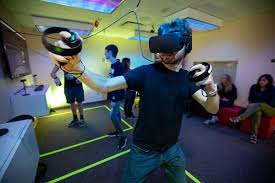Virtual Reality (VR) gaming has transformed the landscape of interactive entertainment, providing players with deeply immersive experiences. One of the key components that significantly contributes to this immersion is audio. Effective audio design in VR games not only enhances realism but also deepens the player’s sense of presence within the virtual environment. This article explores the importance of immersive audio in VR game testing and how it elevates the overall gaming experience.
The Importance of Audio in VR Gaming
In VR games, audio is not merely an accessory to visuals; it is integral to creating a believable and engaging virtual world. High-quality audio can:
- Enhance Spatial Awareness: Accurate sound placement helps players locate objects and navigate environments more intuitively.
- Increase Realism: Realistic audio effects from a professional catalog, like footsteps or environmental sounds, make the virtual world more convincing.
- Boost Emotional Engagement: Well-designed soundscapes can evoke emotions, making the gaming experience more memorable and impactful.
Challenges in Immersive Audio Testing
Testing audio in VR games presents unique challenges that are not typically encountered in traditional game testing. These challenges include:
- Spatial Accuracy: Ensuring that sounds are correctly positioned in the 3D space is crucial. Any discrepancy between audio and visual cues can break immersion and disorient players.
- Platform Variability: VR games are often played on various devices, each with different audio capabilities. Testing must ensure consistent audio quality across all supported hardware.
- Performance Optimization: High-quality audio processing can be resource-intensive. It’s essential to balance audio fidelity with the game’s performance to maintain a smooth and enjoyable experience.
- User Comfort: Poorly designed audio can cause discomfort or even motion sickness in VR. Ensuring that audio contributes positively to user comfort is a critical aspect of testing.
Key Methodologies for Immersive Audio Testing
To address these challenges, developers utilize several methodologies in their audio testing processes:
- Spatial Audio Testing: Using specialized tools to verify the accuracy of sound placement in 3D space, ensuring that audio sources are correctly positioned relative to the player’s location.
- Cross-Platform Testing: Evaluating audio performance on various VR devices to ensure a consistent and high-quality experience, regardless of the hardware used.
- User Experience Testing: Conducting playtests with real users to gather feedback on audio quality, comfort, and its impact on immersion. This feedback is invaluable for making necessary adjustments.
- Performance Profiling: Analyzing the game’s audio processing demands to identify potential performance bottlenecks. This helps in optimizing audio without compromising the game’s overall performance.
Enhancing Realism and Presence Through Audio
The ultimate goal of immersive audio testing in VR games is to enhance realism and presence. By meticulously testing and refining audio elements, developers can achieve:
- Realistic Soundscapes: Creating environments where every sound contributes to the authenticity of the virtual world, from the rustling of leaves to the distant murmur of crowds.
- Dynamic Audio Interaction: Allowing audio to respond dynamically to player actions and environmental changes, further deepening the sense of immersion.
- Emotional Resonance: Using sound to evoke specific emotions and reactions, making the gameplay experience more engaging and memorable.
Conclusion
Immersive audio testing is a critical component in the development of VR games, significantly enhancing realism and player presence. By addressing the unique challenges of VR audio and employing thorough testing methodologies, developers can create truly captivating virtual experiences. As VR technology continues to advance, the role of audio in shaping immersive gaming experiences will only become more pronounced, making dedicated audio testing an essential practice in the industry.






